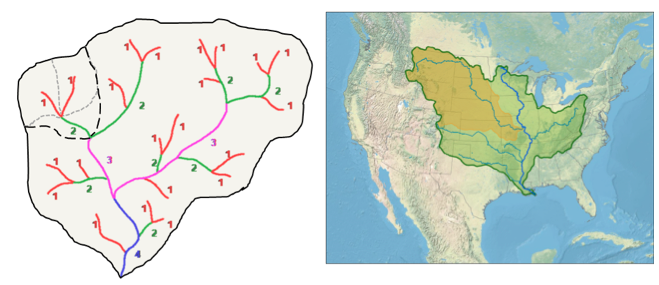Channel Networks and Watersheds
Streams naturally assemble themselves into surprisingly well-organized (quasi-fractal) networks. Figure 2 shows a typical channel network where many small streams converge to make progressively larger streams. The smallest streams in the network, which have no other streams flowing into them, are referred to as first order streams. When two first order streams meet, a second order stream is formed. When two second order streams meet, they form a third order stream, and so on. According to this conventional stream ordering system, first developed by Horton (1945) and refined by Strahler (1957), when a smaller order stream (e.g., first order) meets a larger order stream (e.g., second order), the resulting stream retains the order of the larger stream (in this case, second order).
Each stream has a watershed, also known as a ‘river basin’ or ‘catchment’ because it is the land that ‘catches’ precipitation and funnels it towards the stream. The watersheds of two first order streams are outlined with grey dashed lines in Figure 2. The watershed of a second order stream is outlined in black dashed lines and encompasses the two first order watersheds. The solid black outline in Figure 2 shows the watershed boundary for the fourth order watershed, which encompasses all other watersheds nested within it. The right side of Figure 2 shows the Mississippi River watershed highlighted in green, with the Missouri River watershed nested within it, highlighted in orange. By the time the Mississippi River reaches New Orleans, it is a tenth order stream (though only a few of its largest tributaries are shown in Figure 2), and drains more than one-third of the contiguous US.
The concept of connectivity between rivers and their watersheds will come up again towards the end of this module in the context of restoration. If a particular stretch of stream is impaired for one function or another (e.g., fish habitat has been degraded), in some cases it makes sense to ‘fix’ that specific stretch of river, while in other cases the impairment is simply a symptom of problems higher up in the watershed, so the ‘fix’ may need to be applied at that location in the watershed before human intervention or natural processes can begin to repair the impaired stream. Such is the way that watersheds and streams are connected.

